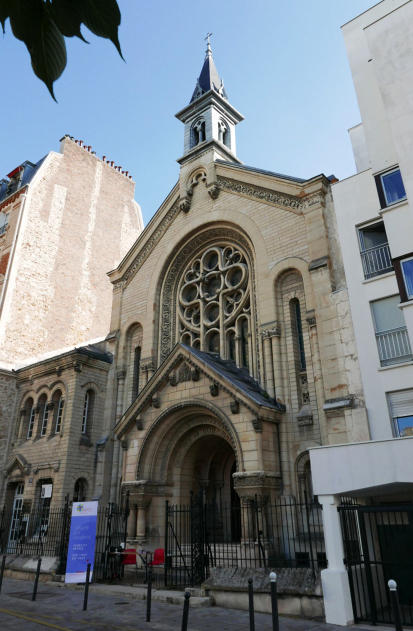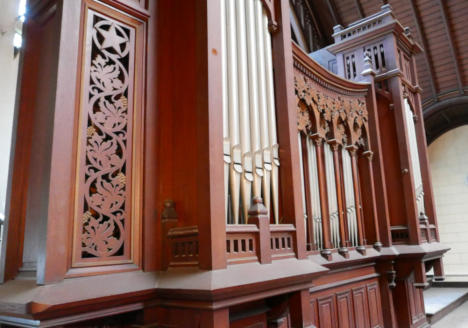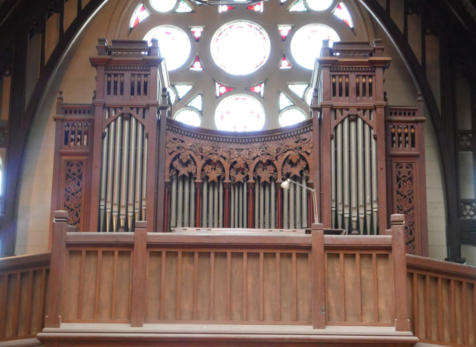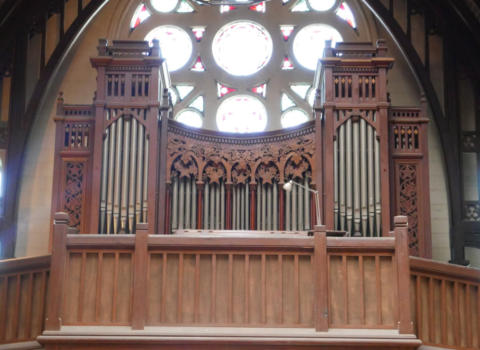



ORGANS OF PARIS © 2024 Vincent Hildebrandt HOME ALL ORGANS


Already under the Old Regime, the suburb of
Saint-Antoine was the district of cabinetmakers
and derivative trades (gilders, lackers,
upholsterers, tanners). There were many German
and Alsatian workers whose immigration had
been favoured by the opening of the Strasbourg-
Paris and Muhlouse-Paris railway lines. In 1863,
faced with the increase of Lutherans in the
district, a first place of worship was built by
Pastor Hosemann on the site of the former
convent of the Benedictines of Bon-Secours, Rue
de Charonne. The cult then took place alternately
in German and French. A school and an
orphanage are created. In 1893, the complex was
transferred to 4 Titon Street. The first stone of the
temple was laid on June 20, 1895 and the building
was inaugurated on May 10, 1896. Its architect
was the Protestant Adolphe Augustin Rey. It is
built in a neo-Romanesque style, mixing Art-
nouveau elements.
The building has the distinction of being
illuminated by a zenithal canopy, supported by a
beautiful pine frame from North America, witness
to the craftsmanship of the Faubourg Saint-
Antoine.
E6
The former instrument was built in 1895 by Merklin. Since
its construction, it has remained totally authentic apart
from a doubling of traction, carried out around 1940 as
well as the addition of a Cymbal III to the GO (perhaps by
Picaud or Sebire?).
In 2020, it was decided to replace the mechanical part with
a second-hand organ. The wooden sideboard has been
preserved.
This second-hand instrument was built by the German
builder Wilbrand in 1994. The organ has 15 registers
spread over 2 keyboards of 56 notes and pedal of 30
notes. It is entirely mechanical.
The pipes (930) are made of tin and wood. It has 1 reed
and 14 foundation stops. The Montre 8' starts at c on the
front. A new frame to support the front pipes frames the
console. It is tinted so as to blend with the dark color of
the old case.
Source



1994 - Wilbrand (3)
II/15 - traction mécanique
Organiste titulaire
?
Concerts
-
Cultes avec orgue
Sunday 10:30 AM
Vidéos
-
Photos: Vincent Hildebrandt (2018)
Organs of Paris
ORGANS OF PARIS © 2024 Vincent Hildebrandt ALL ORGANS

E6
The former instrument was built in 1895 by Merklin. Since its
construction, it has remained totally authentic apart from a
doubling of traction, carried out around 1940 as well as the
addition of a Cymbal III to the GO (perhaps by Picaud or
Sebire?).
In 2020, it was decided to replace the mechanical part with a
second-hand organ. The wooden sideboard has been
preserved.
This second-hand instrument was built by the German
builder Wilbrand in 1994. The organ has 15 registers spread
over 2 keyboards of 56 notes and pedal of 30 notes. It is
entirely mechanical.
The pipes (930) are made of tin and wood. It has 1 reed and
14 foundation stops. The Montre 8' starts at c on the front. A
new frame to support the front pipes frames the console. It
is tinted so as to blend with the dark color of the old case.
Source
1994 - Wilbrand (3)
II/15 - traction mécanique
Organiste titulaire
?
Concerts
-
Cultes avec orgue
Sunday 10:30 AM
Vidéos
-
Photos: Vincent Hildebrandt (2018)





















